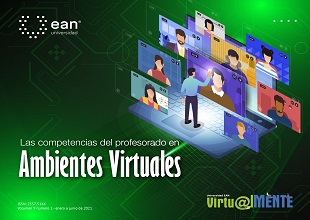Experiencias de la enseñanza y el aprendizaje de la termodinámica, a través de la presencialidad mediada por tecnología
Experiences of teaching and learning thermodynamics, through technology-mediated face-to-face attendance
Contenido principal del artículo
Resumen
El aprendizaje y la enseñanza de la termodinámica es una de las competencias esenciales para la educación en ingeniería industrial. Tradicionalmente, el curso de termodinámica se desarrolla a través de clases magistrales y se evalúa mediante exámenes escritos que incluyen complejas abstracciones. Debido a la emergencia sanitaria por el COVID-19, el curso presencial de Termodinámica para Ingeniería Industrial del Centro Regional Buga de Uniminuto debió pasar a la metodología de presencialidad asistida por tecnología. En este artículo se presenta una estrategia metodológica dirigida a lograr una experiencia de aprendizaje significativa en el curso, a través del trabajo colaborativo de los estudiantes y el acompañamiento permanente del docente. Para el desarrollo del curso se establecieron dos proyectos. El primero busca relacionar los conocimientos adquiridos por los estudiantes con la realidad de la industria y en el segundo se realiza una aproximación a los más recientes avances de las ciencias térmicas, aprovechando los recursos disponibles de las bases de datos de la biblioteca institucional. Finalmente, se relacionan los resultados de la metodología de acuerdo con las principales experiencias de aprendizaje y enseñanza del curso, para evidenciar la necesidad en los currículos contemporáneos de ingeniería, entre la enseñanza rigurosa y correcta, de los principios de las ciencias y la creación de nuevo conocimiento a través del uso de las TIC.
Detalles del artículo
Referencias (VER)
Acevedo, J.; Valencia, G.; Obregón. L., (2020). Development of a new educational package based on e-learning to study engineering thermodynamics process: combustion, energy and entropy analysis. Heliyon, 6(6), E04269. DOI: https://doi.org/10.1016/j.heliyon.2020.e04269
Armas, J.; Lapido-Rodríguez, M.; Gómez, R.; Valdivia-Nodal, Y. (2011). Evaluación termodinámica de sistemas de climatización centralizados por agua helada usando herramientas de inteligencia artificial. Ingeniería e Investigación, 31(2),134-142.
Bailey, M.; Albert, B.; Arnas, O.; Klawunder, S.; Klegka, K.; Wolons, D. (2004). A unique thermodynamics course with laboratories. International Journal of Mechanical Engineering Education, 32(1), 54-77. DOI: https://doi.org/10.7227/IJMEE.32.1.5
Bejan, A. (2018). Thermodynamics today. Energy, 160, 1208-1219. DOI: https://doi.org/10.1016/j.energy.2018.07.092
Bolaños, P. D. (2008). Sistematización del balance térmico en la máquina 4 de Propal S. A (Trabajo de grado). Universidad Autónoma de Occidente. Santiago de Cali, Colombia. Recuperado de https://bit.ly/3zS0gWY
Bonwell, C. C.; Eison, J. A. (1991). Active learning: creating excitement in the classroom. Washington: The George Washington University, School of Education and Human Development. Recuperado de https://bit.ly/3zFNCKs
Boyatzis, R. E.; Rochford, K.; Cavanagh, K. V. (2017). Emotional intelligence competencies in engineer’s effectiveness and engagement. Career Development International, 22(1), 70-86. DOI: https://doi.org/10.1108/CDI-08-2016-0136
Calvo, L.; Prieto, C. (2016). The teaching of enhanced distillation processes using a commercial simulator and a project-based learning approach. Education for Chemical Engineers, (17), 65-74. DOI: https://doi.org/10.1016/J.ECE.2016.07.004
Cardona, M. (11 de abril de 2019). Ser responsables en un mercado que crece. La República. Recuperado de https://bit.ly/3m7ak9k
Caserta, S.; Tomaiuolo, G.; Guido, S. (2021). Use of a smartphone-based student response system in large active-learning. Chemical Engineering Thermodynamics classrooms. Education for
Chemical Engineers, 36, 46-52. DOI: https://doi.org/10.1016/j.ece.2021.02.003
Cengel, Y.; Boles, M. (2012). Termodinámica (7ª ed.). Ciudad de México: Mc Graw Hill.
Foroushani, S. (2019). Misconceptions in engineering thermodynamics: a review. International Journal of Mechanical Engineering Education, 47(3), 195-209. DOI: https://doi.org/10.1177%2F0306419018754396
Imanian, A.; Modarres, M. (2017). Thermodynamics as a fundamental science of reliability. Proceedings of the Institution of Mechanical Engineers, Part O. Journal of Risk and Reliability, 230(6), 598-608. DOI: https://doi.org/10.1177%2F1748006X16679578
Jiménez-Espinoza, A.; Pérez-Martínez, C. (2010). Las emociones en la deserción del conocimiento matemático. Praxis & Saber, 1(1), 191-216. Recuperado de https://bit.ly/3ALyA7m
Lang, A.; Puzinauskas, P. (2008). Adding a continuous improvement design element to a sophomore-level thermodynamics course: using the drinking bird as a heat engine. International Journal of Mechanical Engineering Education, 36(4), 366-372. DOI: https://doi.org/10.7227%2FIJMEE.36.4.7
Maldonado-Currea, A.; Luque-Zabala, A. (2018). Implementación de las TIC en el proceso de enseñanza y aprendizaje de las ciencias, Revista Virtu@lmente, 6(1), 90-98. DOI: https://doi.org/10.21158/2357514x.v6.n1.2018.2107
Mardones, C.; Paredes, C.; Jiménez, J.; Farías, O; Catalán, P. (2015). Tecnologías de control de emisiones y disponibilidad de gas natural como opciones para reducir emisiones de MP2,5 en el Concepción Metropolitano. Revista de Análisis Económico, 30(1), 3-23. DOI: https://doi.org/10.4067/S0718-88702015000100001
Midkiff, K.; Litzinger, T.; Evans, D. (2001). Development of engineering thermodynamics concept inventory instruments. Ponencia presentada en 31st Annual Frontiers in Education Conference. Impact on Engineering and Science Education. IEEE, Reno, EE. UU., 10-13 de octubre. DOI: https://doi.org/10.4067/S0718-88702015000100001
Mulop, N.; K, Mohd-Yusof.; Tasir, Z. (2012). A review on enhancing the teaching and learning of thermodynamics. Procedia. Social and Behavioral Sciences, 56, 703-712. DOI: https://doi.org/10.1016/j.sbspro.2012.09.706
Powell, M.; Rubinsky, P. B. (2019). A shift from the isobaric to the isochoric thermodynamic state can reduce energy consumption and augment temperature stability in frozen food storage. Journal of Food Engineering, 251, 1-10. DOI: https://doi.org/10.1016/j.jfoodeng.2019.02.001
Radmehr, F.; Drake, M. (2019). Revised Bloom’s taxonomy and major theories and frameworks that influence the teaching, learning, and assessment of mathematics: a comparison. International Journal of Mathematical Education in Science and Technology, 50(6), 895-920. DOI: https://doi.org/10.1080/0020739X.2018.1549336
SpiraxSarco. (2018). Accesorios. Recuperado de https://bit.ly/3zLiBEX
SpiraxSarco. (2019). Termocompresores. Recuperado de https://bit.ly/39JIf28
SpiraxSarco. (s.f.). Productos. Recuperado de https://bit.ly/3EQSSPf
Suwa, T.; Kurniawan, T (2020). Redesigning a commercial combined cycle in an undergraduate thermodynamics course: connecting theory to practical cycle design. International Journal of Mechanical Engineering Education, Febrero, 1-20. DOI: https://doi.org/10.1177%2F0306419020904647
Tuttle, K., Wu, C. (2002). Computer-based thermodynamics. Journal of Educational Technology Systems, 30(4), 427-436. DOI: https://doi.org/10.2190/B0X1-R5PW-LCYJ-YYME
Uniminuto. (s.f.). Sistema Nacional de Bibliotecas. Recuperado de https://bit.ly/3m2xRZ5
Vigeant, M. (2021). A portfolio replacement for a traditional final exam in thermodynamics. Education for Chemical Engineers, 35, 1-6. DOI: https://doi.org/10.1016/j.ece.2020.11.010
Wright, K. (2020). Collaborative projects with simulation assignments in mechanical Engineering thermodynamics courses. International Journal of Mechanical Engineering Education, 48(2), 140-161. DOI: https://doi.org/10.1177/0306419018803624
Yang, F.; Qingbo, Y.; Zongliang, Z.; Hou, L. (2019). Thermodynamic analysis of waste heat recovery of aluminum dross in electrolytic aluminum industry. Energy Sources, Part A: Recovery, Utilization, and Environmental Effects, 43(9), 1047-1059. DOI: https://doi.org/10.1080/15567036.2019.1634163
Descargas
Datos de publicación
Declaraciones de autoría
Indexado en
- Sociedad académica
- Universidad Ean
- Editorial
- Universidad Ean









